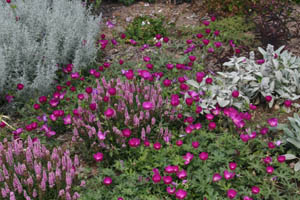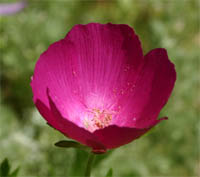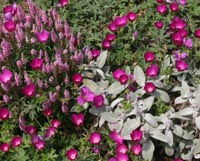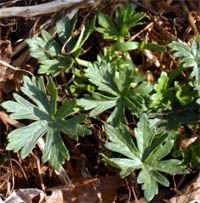
Callirhoe involucrata, commonly called wine cups, purple poppy mallow or buffalo rose, is a native North American member of the Malvaceae (mallow family) hardy in zones 4-8 (probably zone 3 in well-drained soil). This is a small genus of a dozen species that are most diverse in the central United States. Winecups grows wild in dry, rocky areas, such as prairies, pastures, open woods, and roadsides from southern Canada, south to Missouri, Oklahoma, Texas, and Utah. The drought-tolerant perennial produces showy flowers along its sprawling stems all summer long. Although it is only about 4-6 inches tall, it may appear taller as it often grows up and is supported by neighboring plants.

The magenta-colored, chalice-shaped flowers are 1½ -2½ inches wide with a white spot at the base of the five petals. The solitary, upward-facing blossoms open in the morning, close in the evening and remain closed after pollination. Fruits consist of 15-25 kidney-shaped segments stacked together, with each segment containing a single seed.

The rounded, hairy leaves are deeply palmately lobed, and unlike most heat and drought-tolerant plants, are deep green rather than grey or silver. In spring, the foliage emerges from the long, woody tap root that can be up to 5 inches in diameter, with the ground-hugging stems eventually growing about 3 feet long.

The variety tenuissima, Mexican wine cups, is native to higher elevations in the mountains of Mexico. It has the same sprawling habit and cleft leaves but the flowers are a lighter lavender-purple.
C. involucrata was a 1999 Plant Select® winner and also received the Plant of Merit designation from the Royal Horticultural Society.

In the garden, wine cups are ideal for the informal border, and look great spilling over a rock wall or tumbling down a bank. Because of their growth habit, many plants need to be planted together to create a mat of foliage for a groundcover. The long, trailing stems look best growing among nearby plants and won’t smother other plants. The intense wine-red blooms are a striking contrast when rambling through Missouri primrose with its lemon yellow flowers. They also combine well with lamb’s ears (Stachys byzantina), yarrow (Achillea), columbine, daylilies, strawberries, and even prickly pear cactus. They look very natural interplanted with short grasses, reminiscent of their prairie heritage, and are an excellent addition to native plant gardens, wild gardens and naturalized areas or meadows.

Winecups are easy to grow in full sun in well-drained sandy or loamy soils but tolerate clay and infertile soils. They are drought tolerant when established, and will thrive in hot south or west facing beds. The plants die back completely in winter and re-emerge from the crown in spring.

C. involucrata can be grown from seed, but more commonly is available as perennial plants. If attempting to grow from seed, germination will be improved by scarification. This can be accomplished by rubbing the seeds between coarse sandpaper to remove the outer husk before planting. Sow outdoors in late summer or early fall about 1/8 inch deep. The plants self-sow under the right conditions; however, transplanting can be difficult because of the tap root.
Winecups has few pest problems, although crown rot may occur in poorly drained soils. Rabbits are quite fond of the leaves but the plants are supposedly deer resistant.
– Susan Mahr, University of Wisconsin – Madison
Ask Your Gardening Question
If you’re unable to find the information you need, please submit your gardening question here:





 ▶︎ Watch: Hydrangeas: Know Them and Grow Them
▶︎ Watch: Hydrangeas: Know Them and Grow Them ▶︎ Watch: Fall Bulb Planting
▶︎ Watch: Fall Bulb Planting Aster, Symphyotrichum spp.
Aster, Symphyotrichum spp. Fascinating Fasciation
Fascinating Fasciation


